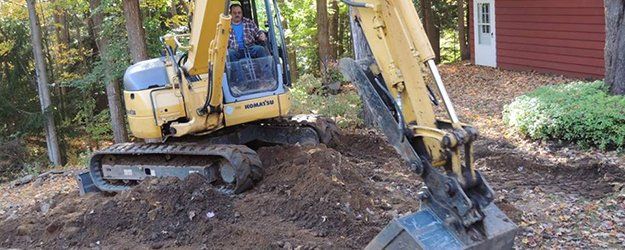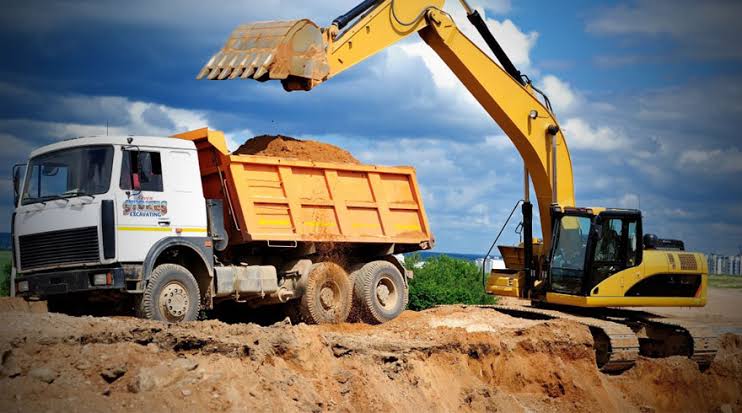Lancaster Excavation - Professional Excavation Solutions in Lancaster, OH
Lancaster Excavation - Professional Excavation Solutions in Lancaster, OH
Blog Article
Introducing the Art of Excavation: Pro Tips for Safe and Efficient Digging
As soil is transformed and planet is moved, the details of excavation expose themselves, requiring a keen understanding of devices, dirt structure, safety and security procedures, and ecological considerations. The proficiency required to navigate these aspects effectively can indicate the distinction between an effective excavation project and a prospective calamity.
Significance of Correct Tools
To ensure the safety and security and efficiency of any type of excavation task, utilizing the suitable devices is vital. Excavation tasks differ in extent and intricacy, varying from tiny residential landscaping tasks to massive building endeavors.
Excavators are essential pieces of machinery in any type of excavating operation. These flexible devices been available in numerous dimensions to fit different project demands. Mini excavators are perfect for smaller tasks, while larger excavators take on extra considerable tasks successfully. Backhoes are an additional crucial tools type, combining the features of a loader and an excavator in one device. They are beneficial for jobs requiring adaptability and maneuverability.
Apart from excavators, various other critical tools includes dump vehicles, bulldozers, and trenchers. Unload trucks are essential for eliminating and carrying excavated products, while trenchers are made use of for excavating slim and deep trenches. Bulldozers master tasks that call for pressing big amounts of soil or particles. By buying the proper tools, excavation tasks can be finished securely, on schedule, and with accuracy.
Recognizing Soil Make-up
An extensive understanding of dirt make-up is basic for executing excavation projects with precision and security. Comprehending the different types of soil is essential as it directly affects excavation techniques, devices choice, and general project efficiency.
Silt particles are smaller sized than sand however larger than clay, offering modest drain and cohesion. Organic issue, such as decomposing plant material, affects dirt fertility and security.
Prior to commencing excavation, performing soil tests to establish its structure and characteristics is necessary. This information aids in selecting the suitable equipment, applying precaution, and developing excavation strategies customized to the specific soil problems - lancaster trenching. By understanding dirt composition, excavation specialists can enhance project results while guaranteeing safety and security and adherence to best techniques
Precaution and Procedures
Recognizing soil make-up is the cornerstone whereupon precaution and protocols for excavation projects are developed, ensuring the wellness of workers and the success of the venture. There are numerous essential measures that have to be applied to alleviate dangers and prevent mishaps. when it comes to security throughout excavation.
First and foremost, before any digging commences, a comprehensive assessment of the website should be conducted to determine any kind of potential hazards such as underground utilities, unsteady soil conditions, or close-by frameworks that could present a threat. It is essential to have a proficient individual supervise the excavation process to make certain that all security methods are followed strictly.
Additionally, all employees involved in the excavation should be effectively learnt risk-free digging methods and the appropriate procedure of company website tools. Personal protective devices (PPE) such as hard hats, high exposure apparel, handwear covers, and security boots should be used whatsoever times to decrease the danger of injuries. septic ohio. Routine security meetings and tool kit talks should additionally be performed to maintain all employees informed concerning possible risks and enhance secure job practices. By sticking to these safety steps and procedures, excavation jobs can be finished efficiently and without incident.
Effective Excavation Planning
When starting an excavation task, careful planning is important to ensure efficiency, safety, and effective results. Effective excavation preparation entails a number of crucial steps that are critical for the smooth implementation of the job. The first action is to conduct a detailed website assessment to recognize any type of potential threats, such as below ground utilities or unstable dirt conditions. This details is important for creating a thorough excavation plan that consists of precaution and take the chance of mitigation approaches.
When the website assessment is total, the following step is to produce a clear timeline and timetable for the excavation activities. This includes figuring out the sequence of tasks, tools requirements, and manpower allowance. Correct scheduling assists stay clear of delays and guarantees that the job remains on track.

In addition, communication among all employee is critical during the planning phase. Clear directives, regular updates, and effective sychronisation are vital for an effective excavation job. By spending time and initiative in thorough preparation, excavation groups can dramatically boost efficiency, reduce threats, and accomplish successful results.

Managing Ecological Considerations
With increasing focus on environmental sustainability in building and construction techniques, managing ecological considerations has actually become an important aspect of excavation tasks. Excavation activities have the potential to affect the surrounding environment with soil disintegration, debris runoff, environment disruption, and contamination of water sources. To alleviate these continue reading this risks, it is essential to carry out best methods that prioritize environmental defense.

Furthermore, proper waste management is vital to stop dirt and water contamination. Applying treatments for the disposal of harmful materials, recycling of waste products, and lessening making use of dangerous chemicals can dramatically minimize the ecological effect of excavation jobs. By integrating these practices right into excavation preparation and implementation, building companies can make certain that their tasks are not just risk-free and productive yet additionally ecologically responsible.
Verdict
Finally, grasping the art of excavation needs a comprehensive understanding of proper tools, soil structure, precaution, and effective preparation. By complying with these guidelines and taking into consideration ecological factors, excavations can be performed securely and efficiently. It is critical to prioritize safety and performance in every digging task to make sure successful end results.
As soil is transformed and earth is relocated, the ins and outs of excavation expose themselves, requiring a keen understanding of tools, soil make-up, safety protocols, and ecological considerations.To ensure the security and performance of any type of excavation task, utilizing the appropriate tools is paramount.A detailed grasp of soil make-up is fundamental for implementing excavation projects with accuracy and safety and security. Recognizing the different types of soil is essential as it directly affects excavation techniques, equipment option, look at this website and overall task effectiveness. By understanding soil composition, excavation specialists can enhance job end results while making certain safety and adherence to finest techniques.
Report this page